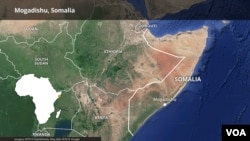This website uses cookies so that we can provide you with the best user experience possible. Cookie information is stored in your browser and performs functions such as recognising you when you return to our website and helping our team to understand which sections of the website you find most interesting and useful.

Al-Shabab militants who crossed into eastern Ethiopia last week are still active inside the country despite claims by local officials that the force has been “destroyed,” say officials and security experts.
Officials on Monday said security forces clashed with al-Shabab fighters in Ethiopia’s Somali state at Lasqurun village, near the border town of Feerfeer. The state’s president, Mustafe Omer, was seen meeting with units of federal military forces who were dispatched to the area.
About 500 al-Shabab fighters, including many who originally came from Ethiopia’s Somali and Oromia regions, entered Ethiopia last Wednesday, multiple security and former al-Shabab operatives told VOA Somali’s “The Investigative Dossier” program. The incursion is the militant group’s biggest-ever operation inside Ethiopia.
Omar Mohamed Abu Ayan, a former al-Shabab official who now lives in Sweden, says the incursion was likely mounted for propaganda reasons.
He said the Islamist militant group, which has been fighting Somali governments and African Union peacekeepers since 2007, wants to show it can operate in Ethiopia as well as Somalia and Kenya.
“If they erect their flag that will be a victory for them,” Abu Ayan said. “They have been dreaming of penetrating Ethiopia for a long time, and to erect their flag. It will mean a huge victory. This will encourage global jihadists to support them.”
What happened?
The operation began last Wednesday when al-Shabab militants shut down telephone networks in Somalia’s Southwest state before carrying out surprise attacks on the Somali towns of Yeed and Aato and Washaaqo village. The towns are all located on the Somali-Ethiopian border and protected in part by Ethiopia’s Liyu police security force.
Somali regional and intelligence officials now believe the militant group’s attacks on those towns were diversionary.
Officials from both sides of the border confirmed that the attacks preoccupied Liyu police forces and distracted them as other heavily armed al-Shabab units crossed the border unopposed.
Mohamed Abdi Tall, the governor of Bakool, the Somali region from where al-Shabab launched the attack, said the militants who entered Ethiopia did not participate in the Yeed, Aato and Washaaqo attacks.
“There were two groups – a group fighting at the border, and a second unit that went through,” he said. “They passed through Aato road while the fighting was taking place; they are headed for Bale region,” between Ethiopia’s Somalia and Oromia states.
Tall said the unit that entered through Aato was confronted and surrounded by Liyu police but made it through despite losing most of their vehicles. He said a second al-Shabab unit that entered Ethiopia from another front, east of El-Barde town, has not yet encountered attacks from Ethiopian security forces.
An intelligence official who did not want to be identified because he is not allowed to speak with the media confirmed the second incursion.
“We were told they crossed the border, but they did not go far,” Tall said. “They are somewhere between us and Gode and Qallafo. We have not heard about them encountering fighting but it’s possible they will.”
Al-Shabab’s objectives in Ethiopia
A former Al-Shabab member who did not want to be named for security reasons said the group’s plan is to erect their black flag inside Ethiopia, and then release a prepared statement declaring that “jihad spread to a new front” in the Horn of Africa. The term jihad means holy war.
Horn of Africa analyst Matt Bryden said the offensive appears to be the start of a major, strategic initiative to establish an active combatant presence in Ethiopia, probably in the southeastern Bale Mountains.
Bryden said although the group suffered some tactical defeats, it has achieved some important objectives, mainly to demonstrate for the first time that al-Shabab is capable of major military operations inside Ethiopia.
“Reports from the field suggest that some AS units have penetrated as far as 100 kilometers inside Ethiopia and may still be active,” he said.
Ethiopia’s domestic unrest and the concentration of troops in the north in the Tigray conflict make this an opportune time for al-Shabab to strike, Bryden said.
Ethiopian forces went to war against rebels of the former ruling group, the Tigray People’s Liberation Front, or TPLF, in November 2020. The conflict in northern Ethiopia between federal government forces and Tigray rebels weakened federal forces and contributed to ongoing instability in the country.
Bryden said he believes the situation with al-Shabab is very serious.
“The scale of this offensive is probably too great to be contained by local Ethiopian security forces – namely the Liyu police in the Somali and Oromia regions,” he said.
“Unless Addis Ababa can afford to redeploy capable military units from elsewhere in the country, then al-Shabab may well succeed in establishing a military presence in Ethiopia for the first time.”
Al-Shabab’s interest in Ethiopia
Founded in Somalia about 15 years ago, al-Shabab has long been interested in exporting its brand of Islamist extremism to neighboring countries. It launched one deadly attack in Uganda in 2010 and has an extensive presence in Kenya. Both countries contribute troops to the African Union forces that have helped Somali governments battle al-Shabab inside Somalia since 2009.
Al-Shabab tried to establish a presence in Ethiopia before, without success. The first armed incursion took place in early 2007 when military commander Aden Ayrow led a unit into Ethiopia in response to Ethiopian troops entering Mogadishu to support the then-transitional federal government of Somalia. The incursion was immediately repelled.
The group’s late leader, Ahmed Abdi Godane, then started training a special unit, named Jabhat, or Ethiopian Front, tasked to carry out attacks in Ethiopia. The unit failed to accomplish much due to robust Ethiopian intelligence, according to Abu Ayan.
Bryden said Godane later tasked al-Shabab's intelligence wing, the Amniyaat, to carry out attacks in Ethiopia.
“These included a failed bomb plot against a football stadium in Addis Ababa in 2013 and suicide bomb attack against a major shopping mall in Addis in 2014 that was disrupted before it could take place,” Bryden said.
With this new incursion, Ethiopia’s Somali region is mobilizing forces and public support. The region said the operation against Al-Shabab fighters who entered the country on July 20 resulted in the killing of more than 100 militants, and destruction of 13 vehicles. The region’s security council said the militants were encircled in the Hulul village area.
The region’s president thanked the population for supporting the security forces.
"I am very grateful to the people of the Somali region who have shown unprecedented unity and stand by their veterans,” he told the region’s state media. “I am confident that the security of the region cannot be disturbed by the terrorism of al-Shabab."



 Africana55 Radio
Africana55 Radio 

